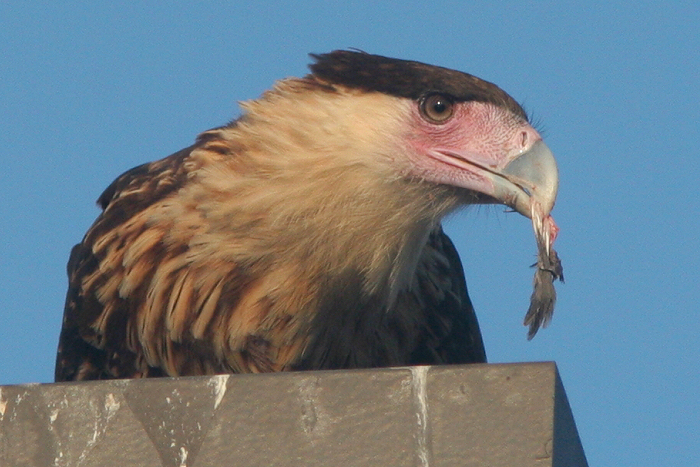
Date: 2006-09-17
Lens: Canon 300mm IS F4 + 1.4x II Converter

 Crested caracara
Caracara cheriway
Crested caracara
Caracara cheriway
 Description
DescriptionBelieve it or not, the Crested Caracara is actually in the same family as falcons. Despite this, the caracara does not move with the same speed or agility as other falcons. The caracara is a scavenger that feeds on a large variety of prey, including reptiles, amphibians, smaller birds, small animals, and even carrion. The caracara often be found along side vultures at fresh kills and carrion. The national bird of Mexico, the Crested Caracara is sometimes referred to as the "Mexican Eagle". Despite being a falcon, the caracara has long legs and can easily run across the ground. In my opinion, this is one of the most beautiful of all birds of prey.
Adult: Black cap with slight crest at the back of the head, giving the bird a "flat-headed" appearance. Very thick, bluish-gray hooked beak, with reddish-yellow cere and bare facial skin around the eyes. Fairly long neck. White throat, neck and upper breast. Dark barring on the back and lower part of the neck. Black belly and back. Broad wings with white base on outer six primary feathers, which can be seen in flight. White rump, uppertail, and undertail coverts. Long white tail with black barring and thick terminal band. Long, yellowish legs. Sexes similar. 19 to 23 inches in length.
Immature: Similar to adult, except it has a brown back, pale buff neck and throat, and dark brown streaking on a pale breast.
Open country, pastures, cultivated areas and semi-desert, both arid and moist habitats but more commonly in the former.
 Nesting
Nesting2-3 eggs. The eggs have a 28 day incubation period. Fledging occurs at 30-60 days. The nest is big, bulky, and made from sticks. The nest is built in a palm, cactus, tree, or on the ground.